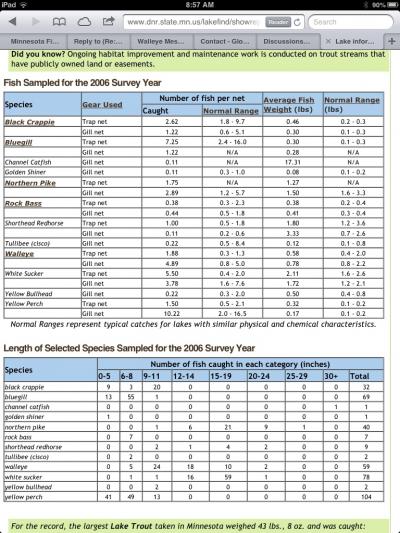I agree with Itch2Fish when he says he doesn’t like to see large populations of any species of fish in the surveys. Depending on the “age” of a lake and the species, I would expect more of certain types of species.
If I am looking for a walleye, smallmouth or musky lake, I am looking at perch, walleye, sucker, smallmouth, musky and whitefish populations and sizes.
A pike or crappie lake, I am looking at pike, crappie sucker, shiner, perch and creek chub numbers and sizes.
Bass or bluegill lake, I am looking at bass, bluegill,etc., mostly bluegill. The reason being that most surveys tell you nets and traps don’t work for bass, only electroshocking.
I like to see a nice distribution of year classes by looking at the # caught by length for the types of fish I am seeking. Personally I am more concerned with balance than seeing they surveyed some trophy fish.
I haven’t looked at the gill net charts much in the past, but I think I will in the future, since they list a “normal range” for similar lakes. If the average weight is above the normal range, there must be something “special” about that lake be it genes, fishing pressure, whatever.
That’s a little background of the bs I use, for what it is worth.
Looking at the charts it looks like a great lake with a lot of balance. Looks like an excellent gill lake or eater walleye lake. Its good to see more gills in the 6-8″ range than the 0-5″ range, because they grow fast the first couple years and then slow down. When you start seeing 0-5″ dominate 6-8″ you are looking at slow growth and stunting. Just look at most metro lake surveys.
And reading the status it reaffirms this saying that the growth for the fish has remained the same as previous surveys and the size and numbers are in the top 25% for similar lakes. At least that is how I understand what 3rd quartile means.
One thing this survey doesn’t have that many metro status reports include is the biggest bluegills caught and % trapped larger than 7″ and/or % larger than 8″. I wish they would do that for all surveys and all species.
If it were me I would certainly give bluegills a try and also some walleye if I was looking for eaters or some action with jigging hardbaits or plastics.
There you have it. How’d I do?


 .
.